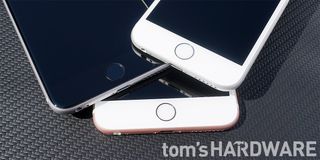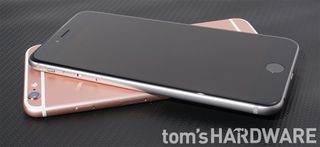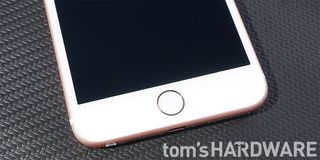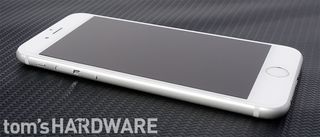Apple iPhone 6s And 6s Plus Review
The iPhone 6s and 6s Plus may look just like last year's iPhones, but hardware updates and Apple's new 3D Touch feature make them feel completely new. While the new cameras and 4K video recording may get the hype, it's the 2GB of RAM that steals the show.
Why you can trust Tom's Hardware
Conclusion
The iPhone 6s and 6s Plus are not completely new phones, but they feel like it. Before we explain why, let's discuss the less significant changes starting with the design. Apart from a new Rose Gold color, the iPhone 6s looks the same as the iPhone 6. The stronger aluminum chassis are technically larger but not enough to notice, unlike the 6s Plus' extra weight, which gives it an extra hefty feel.

The displays are also unchanged, keeping the same size, resolution, and features. Performance parameters, including brightness, gamma, and contrast ratio are also similar to the previous generation, however, our test samples did show improved color accuracy.
Even the new 12MP iSight camera with deep trench isolation technology cannot hold back a sea of sameness. After taking pictures in a variety of conditions, it's difficult for us to see any appreciable difference in quality between the iPhone 6s and iPhone 6. Unfortunately, the iPhone 6s' heavy-handed noise reduction smooths away the very details its extra pixels are trying to capture. Using a more aggressive sharpening filter does slightly increase the perceived sharpness for parts of the image in focus. However, this extra sharpening can hurt the iPhone 6s in lower-light conditions where it tends to emphasize the noise grain. The 6s Plus avoids this problem by leveraging OIS to increase exposure time and reduce noise, a feature the smaller 6s still lacks. While the iSight camera in the iPhone 6s and 6s Plus is one of the best you can get in a smartphone, Samsung's Galaxy S6 remains the leader in photo quality.

Battery life is another metric where the new iPhone 6s models only achieve parity with their previous generation counterparts. The roughly 5 percent reduction in battery size and increase in processor frequencies are equally balanced by the move to a more efficient FinFET process and lower-power LPDDR4 memory. This, plus a smaller screen, is enough to give the iPhone 6s a small advantage over the Galaxy S6 in daily use. Getting through a whole day with either the 6s or S6 without recharging can be a bit of a stretch, though, depending on your usage patterns. The iPhone 6s Plus compares more favorably to its peers and lasts a full day even with extensive use.
One of iOS 9's new software features is Low Power Mode, which underclocks the CPU and turns off some background tasks to extend battery life. Android users have had similar low-power modes, either built into Android or added by an OEM, for some time now. With Apple's usual focus on battery life, it's a bit surprising it has taken the company this long to implement a similar feature. When running the CPU intensive Basemark OS II, we saw an impressive increase in battery life. There's no way to quantify the real-world gains since everyone uses their phone differently, but it's safe to say that this feature does work as advertised.

The similarities documented above seem to suggest an iPhone equivalence principle, where the experience of someone using an iPhone 6 while standing on Earth will be the same as someone else's experience using the new iPhone 6s in an accelerating non-inertial frame of reference. The math, however, does not support this: 1GB of RAM is not equal to 2GB. This single change is enough to make the iPhone 6s feel like a completely new phone. The frequent and frustrating app and webpage reloads that made an otherwise fast phone feel slow are gone. Multitasking on the iPhone 6s is fast and fluid, as is the whole UI; it is easier to move data between apps and much easier to get work done. Sometimes I even leave my laptop at home and just work on the 6s Plus.
Most tasks on the new iPhones feel faster because of Apple's Twister CPU, which has the fastest single-threaded performance of any mobile chip, and custom NVMe-based PCI-E storage solution. Pairing the two additional USCs in the PowerVR GT7600 GPU with higher bandwidth LPDDR4 memory nearly doubles graphics performance too. Excellent frame rates, a large catalog of games, Apple's Metal API, and almost no thermal throttling make the iPhone 6s a good choice for mobile gaming.

Unlike iOS 7's completely new user interface and iOS 8's application extensions, which allow apps to work together and share data, iOS 9's enhancements are more subtle. The most immediate difference is the improved stability (no more SpringBoard crashes!) and generally less buginess compared to iOS 8. Apple's default apps gain some new abilities too, including public transit directions in Maps, better attachment handling in Mail, and Notes grows beyond a simple text editor. There's also a new news aggregator app appropriately called News, and the iCloud Drive app makes iCloud behave a bit more like a true cloud storage service. iOS 9 also resolves the keyboard's caps lock mystery by switching the keys between lowercase and uppercase rather than relying on the nonsensical coloring of the caps lock key alone. Even better, pressing and holding anywhere on the keyboard turns it into a trackpad that allows for more accurate cursor placement and text selection (this works on both the iPhone 6s and 6s Plus). There are a number of other improvements that you can read about in this full iOS 9 review.

This brings us to 3D Touch, a new usability feature exclusive to the iPhone 6s and 6s Plus that adds another dimension, both figuratively and literally, to the standard multi-touch controls. Capacitive sensors integrated into the display's backlight measure the microscopic deflection of the cover glass when pressure is applied to the display. This data is combined with information from the touch sensor and accelerometer to adjust the sensitivity and to cancel out the influence of gravity. Haptic feedback is provided by Apple's Taptic Engine, which can reach peak output in only one cycle, providing a greater range of feedback events.
3D Touch enables several new actions. The one I consistently use and find the most useful is pressing on the left side of the screen to open the app switcher. This works well on the iPhone 6s, but it's a bit of a stretch for a right-handed user on the 6s Plus. It would be nice to have the option of choosing either the left or right side of the screen for this feature. After getting used to this method, double-clicking the Home button feels clunky and archaic.
In addition to pinch-to-zoom, we can now add Peek and Pop to our lexicon of touch-based gestures. Pressing lightly on the screen allows you to "Peek" at the underlying content, like pressing on a URL to see a preview of a webpage or pressing on an address to preview a map without leaving the current app. Pressing a bit harder will "Pop" it open full screen.

At the home screen, pressing lightly on an app icon opens a Quick Actions menu, similar to a right-click context menu, that provides access to common tasks. This feature is a bit hit or miss. First, not every app supports this feature. Second, it's not a big time saver. For example, the Quick Actions for the Camera app allow you to jump immediately into video recording mode, which is kind of useful, but the "Take Photo" option just opens the camera, requiring one extra step than just tapping the Camera icon like normal.
Ultimately, 3D Touch seems like a feature that smartphones should have always had rather than something revolutionary, like the computer mouse. It does contribute to a better overall user experience, though, and that's really what the iPhone 6s and 6s Plus are about. Yes, the A9 SoC is extremely fast, the camera and display are very good, and the rest of the hardware is not bad either, but what sets these new iPhones apart from other phones—and even prior iPhones—is that they are not frustrating to use. I do not find myself shaking my head at poorly implemented features or rolling my eyes when the phone overheats and throttles or cursing under my breath at spontaneous reboots. The iPhone 6s and 6s Plus pass two of my most critical tests: they run smooth and do not slow me down.
Apple iPhone 6s Plus
Apple iPhone 6s
MORE: Best Smartphones
MORE: Smartphones in the News
MORE: All Smartphone Content
Matt Humrick is a Staff Editor at Tom's Hardware, covering Smartphones and Tablets. Follow him on Twitter.
Stay on the Cutting Edge
Join the experts who read Tom's Hardware for the inside track on enthusiast PC tech news — and have for over 25 years. We'll send breaking news and in-depth reviews of CPUs, GPUs, AI, maker hardware and more straight to your inbox.
-
Shankovich I know lots of people are going to trash talk Apple here, but most of us know our hardware and thus should know a bit better. 2 gigs of ram seems low, but Apple's software is highly optimized and we know you can have a bunch of stuff open without it being that noticeable.Reply
Secondly, unless your eye ball touches the screen, you're not going to see a difference between a 1080p screen and above at typical viewing distances for a phone. (If you're going to complain about gaming on it, this site isn't for you). "So why don't they just put a higher res screen on it for the marketing aspect?" Well, aside from them being Apple, which is enough for most people, a higher res screen that most will barely be able to tell from FHD also means more work for the GPU, which means less battery life.
LG, Samsung, etc all do the same thing year over year, that being incremental upgrades, like Apple does. They're all the same. We've reached a saturation point in mobile devices now (probably did 2 years ago). -
10tacle What year is this? Why are we still seeing "new" so-called high end phones with 1080p 5.5" displays and 16GB base memory offerings? And for anyone who says that you can't really see the difference between 1080p and 1440p on such a small screen, get your eyes checked. Happy Samsung Note 5 owner here, upgrading from an 1136p, 326ppi iPhone 5S. (The Galaxy 6 and Note 5 are 1440p with 518ppi for anyone who cares).Reply -
monsta ummmmm don't you think you are just a bit late reviewing this phone that was released months ago ? LOLReply -
iam2thecrowe Seems ok if price isn't an object, most plans include the cost of the phone in a monthly payment now anyway. I will be getting one for work later this year, just hopefully battery life is much better than the 5s which is my current work phone. I wouldn't get one if I had to pay for it out of my own pocket though.Reply -
razor512 While I don't like the iphone, more companies need to follow their lead with the SOC. Instead of focusing on 8 slower cores (of which 4-6 of then remain idle most of the time since many tasks are not multithreaded. Focus on improving the IPC of the CPU and run newer but faster cores.Reply -
Astone3145 "QHD is only really necessary for AMOLED panels (due to having fewer red and blue subpixels than RGB stripe LCD panels), virtual reality applications (because the screen is closer to your eyes), and for people who augmented their genetic code with eagle DNA."Reply
I would love to have access to some of that augmented eagle DNA! -
MobileEditor ReplyI would love to have access to some of that augmented eagle DNA!
Do you struggle to see faraway objects? Find yourself squinting to read small text on your smartphone? Thanks to a breakthrough in genetic engineering, you can permanently upgrade your vision by augmenting your own blueprint with eagle DNA!
* See up to five times farther
* Experience more vivid colors
* See UV light
These are just a few of the advantages that await you after only a single, semi-painless treatment.
This treatment is not approved by the FDA. Some people may experience side effects, including upset stomach, loss of bone mass, accelerated growth of toenails, hardening of the lips, and nose bleeds. Please contact your doctor immediately if you feel the urge to jump from tall structures and soar above the trees, as this could indicate a potentially fatal condition. -
none12345 When your hardware is so far behind the competition its easy to make 70% gains lol. On one hand it's nice to see apple finally putting a little more hardware in their pones; on the other hand, flash is very cheap these days, and only 16 gigs is just downright laughable. The fact that put in like $5-15 more of ram and charge you $100-$300 is just a joke.Reply
And ya at minimum i would expect a 1080p screen, but really 1440p woudl be better. I dont know if phones need 4k in 5-6" just yet, at some point, sure. If you look at all the vr phone boxes coming out lately, you will absolutely notice a huge difference in screen res at a few inches from your eyes. Even 8k is not sufficient for that purpose.
In short tho, too little, too late, no thanks.
